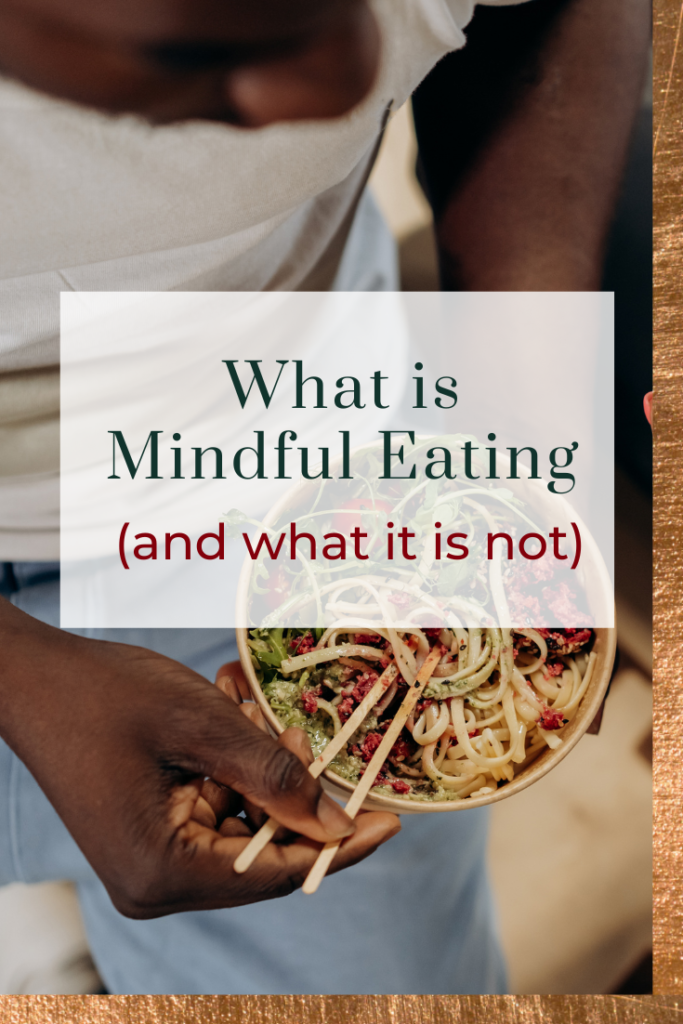Mindful eating can be a helpful tool when you are working on making peace with food, learning to eat intuitively, and listening to your body. Keep reading to learn more about what mindful eating is and what it is not, plus I share 5 tips for mindful eating.
What is Mindful Eating?
The Center for Mindful Eating defines mindful eating as:
“Allowing yourself to become aware of the positive and nurturing opportunities that are available through food selection and preparation by respecting your own inner wisdom…[and] using all your senses in choosing to eat food that is both satisfying to you and nourishing to your body and becoming aware of physical hunger and satiety cues to guide your decisions to begin and end eating.”
The Center for Mindful Eating: Principles of Mindful Eating
From this definition, I’d say that intuitive eating incorporates mindful eating in the following intuitive eating principles:
The intuitive eating framework takes this work a step further by emphasizing the importance of rejecting the diet mentality, finding tools to cope with your emotions, and using gentle nutrition and movement from a place of self-care and body respect.
I like to imagine the intuitive eating framework as an umbrella, and mindful eating is one spoke that helps to support the umbrella. Mindful eating — bringing more non-judgemental intention and awareness to your eating experiences — can be a helpful tool as you work toward moving away from dieting, reconnecting with your body, and making food choices from a place of self-care rather than restriction or deprivation.
Mindful eating can also be thought of as being conscious about what we are eating and why. It is about getting back in touch with the experience of eating and enjoying our food. What it is not: a diet. Eating mindfully does not place “good” or “bad” labels on foods. Instead, the goal is to have more awareness about what is going into our food decisions and base our meals and food choices on body respect.
When Mindful Eating May Not Be Helpful
Most of the clients I work with are out of touch with their feelings of hunger and fullness and they often can’t remember the last time they have felt hungry. They often eat not because they are hungry, but because it is “time” or because the food is there. They may mindlessly munch on bagels during a meeting or graze on snacks after dinner without actually tasting the food, or they may be skipping meals without paying attention to their hunger cues.
This is a very common experience for many people because so many of us are disconnected from our body cues. And often they turn to mindful eating to help them “fix” their mindless eating.
The problem I see is that many people turn the idea of mindful eating into something black and white (binary thinking strikes again!). It becomes something that must be done “perfectly,” where eating must take place with absolutely no distractions (or else it is “mindless”, which is “bad”).
For most people, this interpretation of mindful eating is entirely unrealistic, not to mention inflexible. This approach vilifies “mindless eating,” and partaking in any type of distracted eating comes with a heaping side of judgment that causes feelings of guilt, shame, and failure.
Mindful Eating as a Diet
Approaching mindful versus mindless eating using binary thinking leaves no room for nuance, flexibility, or exploration. It can also turn mindful eating into a type of “diet” – with the hopeful end goal being to “eat less”.
For example, one of my clients had a habit of mindlessly eating popcorn in bed every night, to the point that she would feel uncomfortably full and have difficulty sleeping. In the past, she had tried a variety of ways to “fix” the problem, including eating more mindfully, trying different foods, or attempting not to eat in bed. These solutions would work for a little bit, but inevitably her “habit” would start again.
And it’s no wonder: All of these attempts to “fix” were just diet mentality in disguise. She was using mindful eating to try to eat less of the popcorn. Her inability to do so was causing negative self-shaming and self-judgment. “As soon as I finish the popcorn, my immediate thought is, ‘What the eff is wrong with you? Why are you doing this to yourself? You know that this is why you can’t lose weight,’” she shared with me.
Mindless Eating May Actually Be Helpful
When this client came to see me, she was surprised when I told her that I did not want her to stop eating the popcorn. Clearly, this “mindless” eating had some benefit; otherwise, she wouldn’t continue to do it.
Instead of trying to “fix” the problem by eating more mindfully (which was carrying with it an undercurrent of diet culture), I asked her to try to set aside her guilt and self-judgment and explore the parts of the eating experience that she felt were helpful.
During our conversation, she recalled that popcorn was something she had associated with comfort ever since childhood. Her mother always made her popcorn whenever she had a tough day. Popcorn also signified many happy times from childhood, like when her mother would take her to a baseball game. “Whenever we were able to go to a baseball game and eat popcorn, it meant all was well in the world,” she told me.
Well, no wonder she was having such a hard time “stopping mindless eating.” Not only was she operating from a place of diet mentality but also popcorn had been a powerful coping mechanism for much of her life. Plus, she realized that feeling guilty about eating immediately after finishing meant that any small amount of pleasure she may have gotten was gone right away.
How to Use Mindful Eating in Intuitive Eating Work
Mindful eating can be a helpful tool as you work toward reconnecting and listening to your body. Rather than try to use mindful eating to “fix” a problem, I find that it’s most helpful to use mindfulness techniques to unpack, exploreand get curious about what is happening. That is: being open and aware and curious about your eating experience, from a non-judgemental place.
Try not to approach it with the assumption that mindful eating will help you eat less – because this will likely serve to keep you in the dieting cycle and disconnected from your body.
Instead, you can use mindful eating to notice, pause, check in with yourself, and explore your thoughts and feelings surrounding your experiences. In this way, mindful eating can be a useful tool to help you reconnect with your body and get back to a place of eating more intuitively.
One note before I jump into the tips: for some neurodivergant people, interoceptive body cues may not be accessible – and that is okay! Many people need to have outside cues like timers for example, to help them decide when to eat. For others, like folks with sensory issues, parts of mindful eating may not be helpful. So please take what feels helpful, and leave what does not. As always, you know your body best.
How to Practice Mindful Eating
If you’re in a place where you think it would be helpful to bring more mindfulness to your eating experiences, here are a few tips that you can try. Remember: not all these tips might feel helpful, so be sure to notice if or when anything I say is bringing up diet mentality or all-or-nothing thinking for you. Take what is helpful, leave what is not.
5 Tips for Mindful Eating
1. Get Curious At Mealtimes
The next time you’re eating, take a moment to check in with your body and get curious:
- What thoughts and feelings came up as you were choosing and making this food?
- What was your intention behind choosing this food?
- How does the food look? How does it smell?
- As you start to eat: How does the food taste? What else are your senses telling you? (think texture, temperature, etc.)
- Is the food you’re eating satisfying? Why or why not?
- What might make this a more satisfying meal or eating experience?
- How does this food feel in your body – both when you’re eating it and after you’re eating it?
Try to use mealtime to build more curiosity and non-judgmental awareness. Don’t necessarily try to change anything, especially right away. Just notice what you notice.
And if you don’t notice anything – that is okay too! It can take time and practice of tuning into your body and the eating experience to build more awareness of what you feel.
2. Reconnect with and Practice Honoring Your Hunger and Fullness
Another tool that might be helpful as you work to connect more with your body cues is the hunger-fullness scale. Think of hunger on a scale from 1 to 10, 1 being “I’m so hungry I’m going to pass out” and 10 as “I’m so full I’m going to be sick.”
Before you eat, ask yourself where on the hunger scale you fall. Most eating experiences feel best when we eat when we are around a 3 or 4 (anywhere from “I’m slightly hungry” to “I’m hungry, and it’s time for my next meal”).
Then check in with yourself mid-meal, how does your body feel now?
These numbers, as I’ve just described them, may not best suit your experience or sensations of hunger. As you practice tuning into your body and bringing awareness to your hunger cues, it may be helpful to personalize the hunger-fullness scale based on your hunger cues. Make note of what feelings and sensations seem to correlate with the ravenous/starving low end of the scale and which ones seem to signal earlier signs of hunger.
3. Try to Be Present-Focused
When you honor your inner wisdom, you are present-focused. You are noticing and becoming more attuned to how your body feels in that moment and honoring that feeling.
If you find yourself saving up for meals or choosing (or avoiding) certain foods based on what you might eat later, you are future-focused. It is impossible to know what your body will need later on or how you will feel when you get there.
When you base current eating decisions on what you think might happen in the future, it will prevent you from being able to reconnect with your body cues. Bring yourself back into the present moment, check-in with your body, and challenge yourself to honor your body’s desires.
4. Slow Down (if it’s helpful)
If you are someone who eats quickly, it may help to slow down. Before you do, though, I’d encourage you to get curious: why do you eat so quickly? When did this fast-eating begin? What might be playing into this?
For example, a client of mine realized that her quick eating started in childhood, because she grew up eating family-style meals with four older brothers who ate a lot. So if she wanted to get enough food, she had to eat fast. It made so much sense why she was still eating quickly now as an adult, even if there was enough to go around – her body had ingrained that scarcity as a kid.
Slowing down may help you to be able to take time to enjoy your food. You’re also more likely to notice when you are full, allow for better digestion, and notice flavors you might have otherwise missed.
You might try to take a few bites, and then put your fork down. Talk with those around you. Chew slowly, and pay attention to the texture of the food, the flavor in your mouth, and the aromas.
Slowing down your eating can help you recognize your body signals and can make for a more meaningful meal.
5. Pay Attention to How Food Affects Your Body
Take time to notice how you feel not just while you are eating, but after you eat. Do you feel satisfied with the meal, or do you still want more? How long do you stay full? How is your energy level? How does your body feel?
Observe how you feel after eating different types of foods. Maybe you find that one type of snack causes an initial spike of energy, but is followed by a crash an hour later; while another snack gives you more consistent energy throughout the day.
Try to approach these observations with curiosity, not judgment. One food is not better than the other, they just may make you feel differently afterward.
Looking for more mindful and intuitive eating support?
Check out my Unapologetic Eating 101 Coursean online, self-paced program to liberate yourself from dieting and make peace with food and your body.
My team and I also offer virtual one-on-one support – you can check out our virtual intuitive eating nutrition coaching packages.
My book, Unapologetic Eating: Make Peace with Food and Transform Your Lifeis also a great resource that includes information, research, and reflection prompts to help you move away from dieting and come back home to your body, so you can live your most unapologetic, liberated life.








